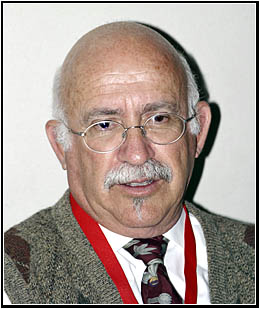ON:
Mr. Harold Koopowitz, your lecture in Dijon concerns the "CITES,
its Evolution and the History of Attitudes Towards It". You have
a very firm opinion about the CITES. Please, could you develop this
question?
HK: Much of CITES does not have to do with real
conservation. To my mind, it should be not working with hybrid plants.
I think all the hybrids should be taken off. Regulating movement of
dried herbarium specimens also has nothing to do with conservation.
When they list something they should know or have good evidences that
it is really in danger in the nature. The attitude that if one does
not have enough information that one should play safe and regulate simply
does not work for plants. There is a lot of bureaucracy involved in
running CITES and it is very expensive, not only for the commercial
growers, but also for the countries that have to carry out the treaty.
90 percent of the regulation work has to do with hybrid plants. So I
think money that they spend in such regulation, would be better spent
if they were buying forest or helping conservation for really endangered
animals or plants. By regulating plants that are not truly endangered
all they have done is loose the support of the orchid growing public.
If you look at their published list of endangered species they illustrate
it with a picture of a Dendrobium hybrid. This indicates they
do not really understand what they are doing. One can illustrate that
CITES does not work. When they uplisted the two genera Paphiopedilum
and Phragmipedium to Appendix I, it did not reduce collecting
pressures on the wild populations. In the latter case (Phragmipedium)
it increased it. It did not stop collections in the wild and newly discovered
species (e.g. Paph. vietnamense), since uplisting, are now highly
endangered or collected out. The increased red tape makes it difficult
to artificially reproduce Paphiopedilums and carry out ex situ conservation.
In the past CITES placements were not based on real evidence, just the
opinion of people who considered themselves experts. Many species which
looked as if they were very threatened are now known not to have been
endangered.
ON:
Why do you think that CITES works against ex situ species conservation?
HK: With orchids listed in Appendix I one needs
to be able to show that the original plants of the species were collected
legally. This is not always possible. A good example are the Vietnamese
slipper orchids. These were all collected illegally to the point of
endangerment. Some may not even exist in the wild anymore but they are
widespread in cultivation (illegally). Prohibiting trade in these species
is now illogical because they will go exinct unless they are allowed
to be propagated artificially. But that is forbidden.
On: What kind of changes can you suggest for CITES list?
HK: All hybrids should be removed. All artificially
propogated materials should be removed. Scientific herbarium specimens
should be removed. Only truly endangered species should be listed. CITES
should not regulate movement of dried herbarium specimens. CITES should
also condone, encourage movement of salvaged materials.
ON: What kind of cooperation between commercial nurseries and conservationists
can promote conservation?
HK: I think that the current regulation of Phragmipedium
kovachii allowing a few nurseries to propagate and sell flasks
of P. kovachii and its hybrids under Peruvian government control
makes an excellent model.
ON: You are the editor of one of the most important magazines on orchids,
'Orchid Digest'. In your magazine, is it possible to do something for
conservation or is the purpose is not that?
HK: Well, we want to promote conservation and
in the past, we have actually issues devoted to conservation but at
the present time that is not our main goal. We are, however, always
interested in articles on conservation, both about successes and failures
and would be happy to consider any new material on those subjects. I
must warn that it we have a backlog of articles and it can take as long
as one to two years to get published.
ON: Thank you.
|
Any
kind of reproduction (print, digital or anyone other) of any
type of material of this site - texts, layout, photos, images
and others - is strictly forbidden without previous written
permission by the authors.
|

